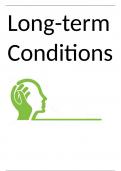Long-term
Conditions
,Chronic Lower Back Pain
Chronic lower back pain = “pain that continues for 12 weeks or longer, even after initial injury or
underlying cause of acute lower back pain has been treated”
5 - 10% of lower back pain
Second leading cause of disability worldwide
Anatomy
Epidemiology:
1. CLBP has increased by 100% in adults (increasing with an ageing population)
2. 3 - 4 times more likely in people over age of 50 than 18 to 31
3. Higher prevalence in females in lower economic status, less schooling and people who smoke
Pathophysiology
- Pain mediated by nociceptors (specialised peripheral sensory neurons alerting to damage stimuli)
- Central sensitisation caused by increase in the excitability of neurons within CNS; normal inputs
produce abnormal responses
- Minimal changes in posture leads too long-lasting inflammation in joints, ligaments and muscles
used within the stability of the back leads to peripheral and central sensitisations
Spinal pain:
Radicular pain Originates from inflamed/lesioned dorsal roots/ganglia, radiating from
back/buttock into the leg (dermatomal distribution).
Caused primarily by disc herniation; nerve inflammation is more common
than compression.
Pain along the nerve root without neurological impairment; unlike
radiculopathy which causes sensory/motor impairment.
Diagnosis: Clinical exams (manual muscle testing, straight leg raise, Lasègue
sign), MRI, CT/CT myelography, and electrodiagnostic studies.
Facet joint Lumbar zygapophyseal joints have abundant nerve endings activating
syndrome nociceptive pathways.
Accounts for ~30% of chronic lower back pain.
Diagnosed through clinical assessment and radiological exams.
Symptoms: Lower back pain, sometimes leg pain above the knee, no
radicular pattern.
Pain worsens with hyperextension, rotation, bending, walking uphill,
prolonged sitting.
Radiological imaging (MRI, CT, X-rays) supports diagnosis, but history and
clinical exams are fundamental.
Sacroiliac joint SIJs support the upper body, influencing sacral movement and impacting
pain lumbar joints/discs.
Innervation sources: Ventral lumbopelvic rami and posterior rami.
Common source of chronic lower back pain (CLBP).
Diagnosed via physical exams, stress tests, and MRI findings.
Often underdiagnosed, linked to postural LBP and rheumatic diseases.
Understanding SIJ pain involves considering biomechanical issues, nerve
involvement, and musculoskeletal condition associations.
Lumbar spinal Can be congenital, acquired, or a combination; commonly degenerative
stenosis due to aging.
, Symptoms: Midline back pain, radiculopathy, motor weakness,
paraesthesia, sensory impairment.
Symptom distribution: Central stenosis (bilateral pain), lateral recess
stenosis (unilateral radiculopathy-like symptoms).
Diagnosed via history, physical exam, and MRI.
Management involves understanding symptoms, diagnostic methods, and
conservative vs. surgical treatment outcomes.
Discogenic pain Accounts for ~39% of CLBP cases; axial/nonspecific symptoms without
radicular radiation.
Involves NP matrix degradation and AF fissures.
Inflammation is pivotal, with nerve growth and pro-inflammatory
molecules contributing to pain.
MRI reveals endplate changes and Modic type 1 changes; some patients
respond to antibiotics.
Provocation discography's clinical utility is contentious due to poor specificity
and potential complications.
Clinical presentation:
Pain in lower areas
Movement / coordination impairments
Difficulty maintaining neutral positions
Bending over provokes symptoms
Pain is generalised causes sensory impairments
Fear-avoidance beliefs
Red flags:
Cauda equina syndrome
Cancer
Ankylosing spondylitis
Lumbar Spinal Stenosis
Lumbar disc herniations
Lumbar Spine Fracture
Spondylodiscitis
Abdominal Aortic Aneurysm
Diagnosis:
Fewer than 10% of cases are diagnosed with radiography and magnetic resonance imaging (MRI).
Degenerative changes and conditions such as spondylolysis and spondylolisthesis are not reliable
diagnoses for CLBP, as they are no more common in patients with pain than in asymptomatic
individuals
Generally, patients are diagnosed based on their history. The specific diagnosis is then formulated based
on the examination and clinical outcomes.
Outcome measures:
STarT Back
Oswestry Disability Index
Roland‐Morris Disability Questionnaire
Patient-specific functional scale (PSFS)
The loaded forward-reach test




